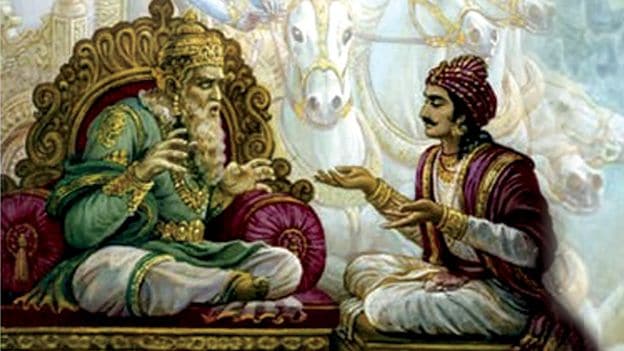By- Gautam Sidharth
Mahabharata is not simply called an epic. The way the story has been narrated from different perspectives and the detailed explanation or reasoning every character has been given – all adds up to making it an epic. We have number of positive or heroic roles as well as bad ass guys. However, some characters have not been interpreted and perceived in the way they deserve to have been. A closer look at these characters will justify my statement.
SHAKUNI

The grand juari (gambler), the vamp of Mahabharata, the evil uncle who instigated his nephew against the Pandavas, thus beginning the war that ended the reign of the Kuru empire, Shakuni was many things. But little do people know about his life. What really made him so? It is said that in some military campaign of the Kuru empire, Gandhara (Shakuni’s home) came under attack from Hastinapur (belonged to Kaurvas or the Kuru empire). Hastinapur conquered Gandhar, killed its King and imprisoned all the male members (Shakuni and his 100 brothers). All of them, being prisoners of war, were not given much food (one grain of rice each per day as stated in the texts).
To make at least one of them survive all the other members gave their share to Shakuni, the most cunning of them all, so that he could live on to take revenge. Later the Gandhar Kingdom entered a truce and Shakuni’s sister Gandhari was married to Dhritarashtra, the Head of the Kuru Kingdom. Shakuni was pissed because his sister Gandhari was married off to a Blind Horny Man who had destroyed his life and family. It is well known that Gandhari had a hundred children! It was this event that made him ever so determined to shred the Kuru empire to pieces! Shakuni then carved from the bones of his dead parents’ dice that never lost him a game. Shakuni’s father’s soul was said to have entered the dice and it would roll to whatever number he desired. An expert in the game of “chausar” he successfully transmitted this ‘harmless’ vice to the Kauravas. It was through this game later that the foundation for the bloodiest battle in the Indian history was laid!
SANJAYA

Sanjaya, the minister and charioteer of Maharaja Dhritarashtra, was the King’s first choice for diplomatic missions. He is also the man through whose eyes we witness the battle of Kurukshetra. The Mahabharta begins with “Sanjaya uvachh” or thus spoke Sanjaya. Blessed with the ability to see the war from a far off place Sanjaya delivers excruciating details about the same to the King such as the detailed account of the death of his hundred sons.
However some scholars debate this ability because the Mahabharta begins with Sanjaya narrating the death of Bhishma, the army commander for the Kaurvas or the Kuru empire, and since Bhishma’s death took place on the tenth day of the war, it is believed that Sanjaya was present on the battlefield for the first ten days of the battle and only returned to Hastinapur once he was dead, thereby narrating the events that had taken place on the first ten days of the war, the army formations, battle strategies, so on and so forth. So basically we owe a lot to him, had he not come back from the war, the epic would never have existed.
SHIKANDI

Fighting for the Pandavas, Shikhandi, arguably the first transgender to have been officially registered in the texts is an unusual character. It is believed that Shikhandi was born a woman but was raised as a man by her father. Other stories state that Shikhandi was a woman Amba in her previous life who was abducted by Bhishma from her swayamvara (so abductions were a common thing for the Haryanvis even then), Bhishma wanted to claim her and her sisters for his brother. But since Amba was in love with someone else, she was exempted. – (Yeah, right! – he had the other two sisters).
But when Amba reached her boyfriend, he kicked her out because he fancied her no more. Broken Amba requested Bhishma to marry her typical ‘Khap panchayat mentality’ but Bhishma refused as he had taken a vow of celibacy. Amba then vowed to destroy Bhishma. She wandered off to the forests and indulged in austerities. Shiva then, impressed by her devotion gave her the boon of being born as a male (lol!) in the next life. Thus was born Shikhandi, against whom Bhishma refused to fight as she was a woman. (wow..not shy to abduct a woman but are shy to fight her…bloody hypocrite!)
EKALAVYA

Refused the right to education by Drona, the Pandava guru (because he belonged to an outcast tribe of Hastinapur), Eklavya self-trained in the art of archery. Once Drona was roaming in the jungle with the Pandavas and Arjuna came across a dog whose mouth had been so skillfully shut by arrows that it did not kill the creature but only prevented the thing from barking.
Impressed by the skill, Drona called upon the archer, to his surprise it was Eklavya who had learnt the art by devoting himself to a statue made out of dirt that resembled his teacher. An insecure Arjuna was now having second thoughts about his guru’s promises of making him the world’s greatest archer.
A cunning drona then asked Eklavya to cut off his right thumb and give it to him as Guru Dakshina or fees. Eklavya did so without delay.
KARNA

The son of Lord Surya and Queen Kunti, a bastard, he was insulted everywhere. He disguised himself as a Brahmin and became a disciple of Parasurama. His own brothers, the Pandavas, enjoyed the princely status but he had to make do with the selfish help from Duryodhana, the Kuru prince, for which he fought on the Kaurava’s side. In the unfair war Karna had many opportunities to kill his brothers the pandavas but he did not for he had made a promise to his mother Kunti that Arjuna would be the only Pandava he would kill.
Deceitfully killed when out of his chariot and weaponless by Arjun, his was not the righteous death. He stayed with Kauravas until his last breath out of friendship and a thankful heart. When we read Mahabharata, often the greatness of Karna is sidelined as he is portrayed on evil side.
Feature Image Source














